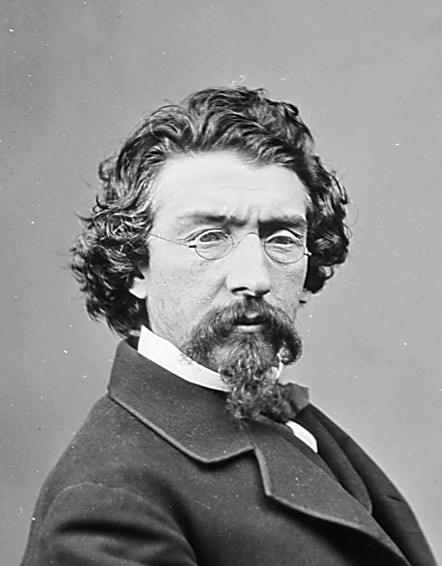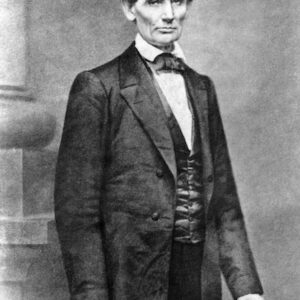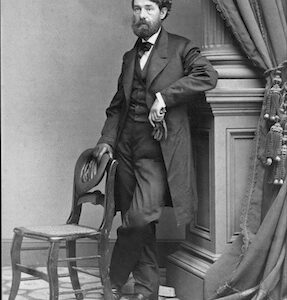Tag: by Brady (Mathew B.)
 Wikipedia says: Mathew B. Brady (May 18, 1822(?) – January 15, 1896), the son of Irish immigrants, was born in Warren County, New York. Brady would spend his fortune to accumulate photos of the war. In the early 1840s, Brady was a manufacturer of “jewel cases” for daguerreotypes in New York City. By 1844 he had opened his own daguerreian gallery at 205 Broadway, the “New-York Daguerreian Miniature Gallery”, having with Edward Anthony in 1840 received instruction from Prof. Samuel B. Morse for a fee of $50. Still in his 20s, Brady’s next goal was to establish at his hall of fame, a Gallery of Illustrious Americans. “From the first, I regarded myself as under obligation to my country to preserve the faces of its historic men and mothers.” Brady returned to New York in May 1852 after a long absence in Europe. While there he sought treatments for an undisclosed illness (mercury poisoning?). In 1856, seeing the tremendous potential for reproducible, enlarged prints and their purpose for the illustrated newspapers, Brady hired photographer and businessman, Alexander Gardner for his Washington City studio.
Wikipedia says: Mathew B. Brady (May 18, 1822(?) – January 15, 1896), the son of Irish immigrants, was born in Warren County, New York. Brady would spend his fortune to accumulate photos of the war. In the early 1840s, Brady was a manufacturer of “jewel cases” for daguerreotypes in New York City. By 1844 he had opened his own daguerreian gallery at 205 Broadway, the “New-York Daguerreian Miniature Gallery”, having with Edward Anthony in 1840 received instruction from Prof. Samuel B. Morse for a fee of $50. Still in his 20s, Brady’s next goal was to establish at his hall of fame, a Gallery of Illustrious Americans. “From the first, I regarded myself as under obligation to my country to preserve the faces of its historic men and mothers.” Brady returned to New York in May 1852 after a long absence in Europe. While there he sought treatments for an undisclosed illness (mercury poisoning?). In 1856, seeing the tremendous potential for reproducible, enlarged prints and their purpose for the illustrated newspapers, Brady hired photographer and businessman, Alexander Gardner for his Washington City studio.
Mathew Brady’s unequaled fame derived from his shrewd ability at self-promotion and a strong determination to succeed as the foremost portrait photographer of his day. He would also become known as the most prominent photographer of the American Civil War. From the very beginning Brady determined to accumulate as many war views as possible, with the understanding that in the not too distant future a photomechanical means of reproduction would be possible. With this end in mind, Brady made, exchanged, borrowed and copied prints and negatives. If there were duplicate views to be had, he bought those. In light of Brady’s practice, it is not surprising therefore, that a very large number of war views in his vast collection, that were not actually his, came to be associated almost exclusively with his name. Nearly every photograph associated with the struggle seemed to be a “photograph by Brady.”
At the beginning of the war, Mathew Brady secured the necessary permissions, purchased rugged cameras and traveling “darkrooms”, and sent his employees out to begin documenting the struggle, all at his own personal expense. The First Battle of Bull Run provided the initial opportunity to photograph an engagement between opposing armies, however Brady returned with no known photographs from the battlefield. Following the Federal rout, he arrived back in Washington D.C. the day after the battle and was photographed at his studio wearing a soiled duster and sword. Tantalizingly little is known about Brady’s life, as he kept no journals, wrote no memoirs and left but few written accounts.
By war’s end, Brady estimated he had spent $100,000 to amass more than 10,000 negatives that the public no longer showed an interest in. In 1875, the War Department came to Brady’s relief and purchased for $25,000 the remainder of Brady’s collection. Anthony Company possessed another immense collection of Brady cartes-de-visite and war negatives, received by them as compensation for Brady’s continued indebtedness. From the War Department, the collection devolved to the U.S. Signal Corps, and in 1940 it was accessioned by the National Archives. On January 15, 1896, Brady died penniless in the charity ward of Presbyterian Hospital in New York City. However, in his last days, Brady did not die in isolation. He was visited and comforted often, by friends and admirers up until the very end. His funeral was largely financed by the friends of his adopted regiment, the 7th NYSM.
While it is true that in the beginning, at his own expense, the enterprising Mathew Brady secured the necessary permissions from the War Department for the purpose of documenting the “rebellion”, it would largely be others, particularly those photographers who were under the direct supervision of Alexander Gardner, who would follow the armies and ultimately fulfill the difficult task of recording for posterity a timely, consecutive photographic history of the American Civil War.
Showing all 2 results

